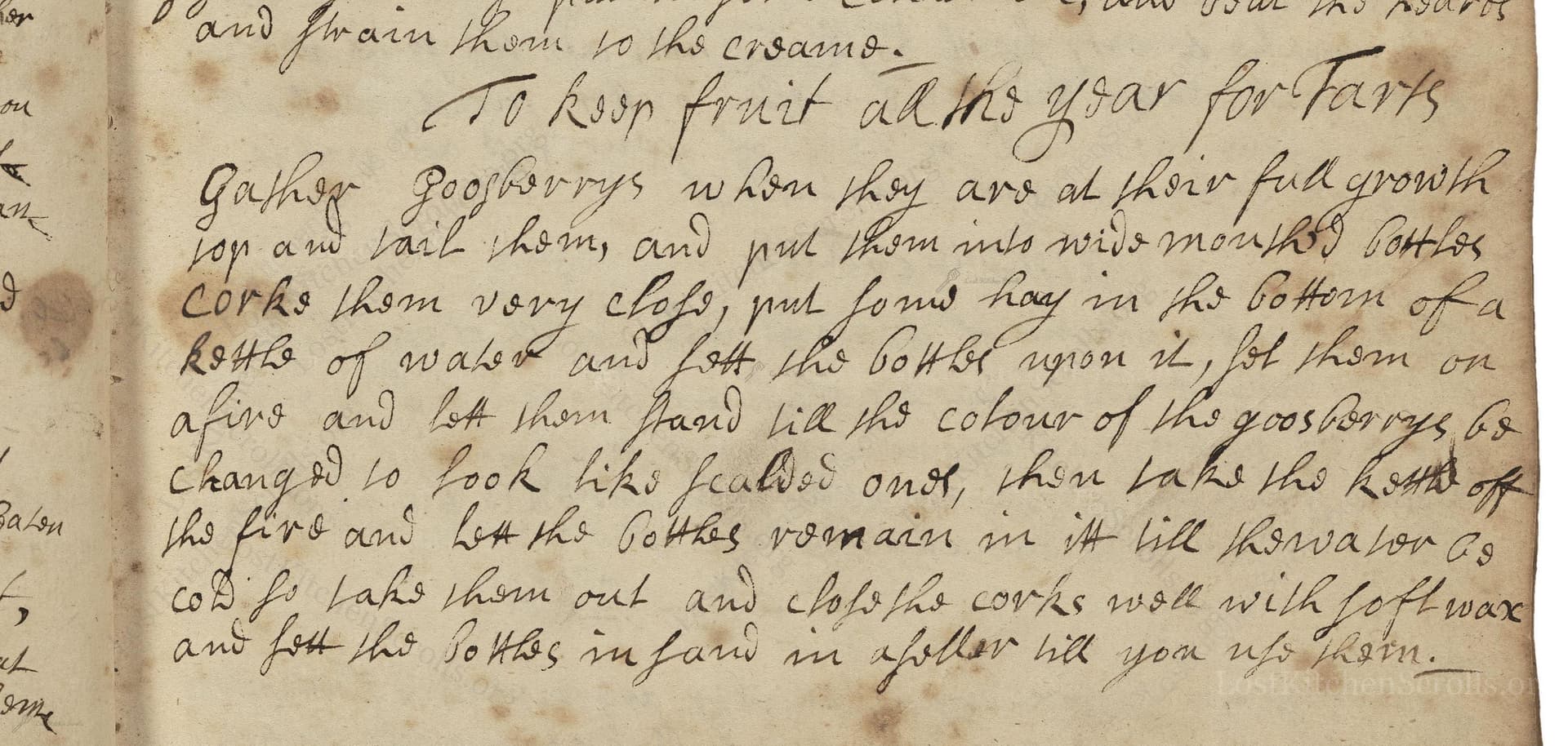To Keep Fruit All The Year For Tarts
From the treasured pages of Receipt book of Jane Staveley
Written by Jane Staveley

To Keep Fruit All The Year For Tarts
"Gather goosberrys when they are at their full growth top and tail them, and put them into wide mouthed bottles corke them very close, put some hay in the bottom of a kettle of water, and set the bottles upon it, set them on a fire and let them stand till the colour of the goosberrys be chang'd to look like scalded ones, then take the kettle off the fire and let the bottles remain in it till the water is cold, so take them out and close the corks well with soft wax and set the bottles in sand in a seller till you use them."
Note on the Original Text
The recipe is written in continuous prose, a hallmark of early modern English manuscripts, with instructions embedded within the text rather than itemized steps. Spellings like 'top and tail them' and 'corke them very close' reflect period conventions and variable orthography, since English spelling was not yet standardized. Measurements, heat levels, and times are inferred from observable changes—such as 'till the colour of the goosberrys be chang'd'—demonstrating a reliance on experience and common sense rather than precise numerical guidance.

Title
Receipt book of Jane Staveley (1693)
You can also click the book image above to peruse the original tome
Writer
Jane Staveley
Era
1693
Publisher
Unknown
Background
Step into the flavorful annals of the 17th century with Jane Staveley’s delightful culinary collection. Brimming with time-honored recipes and refined instructions, this book offers a sumptuous glimpse into the kitchens of yesteryear—where classic techniques met noble tastes and every dish was a celebration of ingenuity.
Kindly made available by
Folger Shakespeare Library
This recipe comes from the late 17th century, specifically from Jane Staveley's recipe collection dating to 1693-1694. In a time before refrigeration and modern canning, preserving summer fruits for winter use was essential. Households relied on ingenious methods for keeping fruit edible, especially for beloved tarts and desserts. The use of corked bottles, gentle heat, and wax seals predates later Victorian canning techniques, representing an early form of hot-water preservation. Cellars acted as home pantries, and sand was often used to buffer bottles and regulate moisture. This recipe sheds light on domestic skills and seasonal rhythms in an English home of the era.

Historically, cooks would have used wide-mouthed glass bottles—commonly available in well-stocked English kitchens of the late 1600s—sealed with natural cork. A large iron or copper kettle, a hearth fire or stove for heating water, and clean hay or straw to cushion bottles during heating were typical. Wax (from bees or tallow) finished the seal to keep out air and spoilage. Sand-filled cellars provided cool, stable storage.
Prep Time
20 mins
Cook Time
30 mins
Servings
10
We've done our best to adapt this historical recipe for modern kitchens, but some details may still need refinement. We warmly welcome feedback from fellow cooks and culinary historians — your insights support the entire community!
Ingredients
- 2.2 lbs fresh gooseberries (green or red, substitute with currants if unavailable)
- Sterilized, wide-mouthed glass bottles with corks or sealing lids
- Clean hay (or substitute with a clean kitchen towel)
- Beeswax or paraffin wax for sealing
Instructions
- To preserve gooseberries for making tarts year-round, start by selecting fresh gooseberries at the peak of their ripeness (about 2.2 lbs).
- Remove the tops and tails with kitchen scissors.
- Place the cleaned berries into sterilized, wide-mouthed glass jars.
- Seal loosely with corks.
- In a large pot, lay a layer of clean hay or a folded kitchen towel at the bottom to buffer the jars.
- Place the jars on top, fill the pot with water up to the neck of the jars, and heat gently until the berries change color and look as if they've been lightly blanched (about 167–176°F).
- Remove the pot from the heat and let the jars cool in the water completely.
- Take out the jars, seal the corks tightly, and cover seals with melted paraffin wax or beeswax.
- Store the jars upright in a cool, dark pantry or cellar, optionally surrounded by clean sand, until needed.
Estimated Calories
44 per serving
Cooking Estimates
It takes about 20 minutes to prepare the gooseberries and jars, and 30 minutes to heat them in the water bath. Each serving is about 100 grams of preserved gooseberries.
As noted above, we have made our best effort to translate and adapt this historical recipe for modern kitchens, taking into account ingredients nowadays, cooking techniques, measurements, and so on. However, historical recipes often contain assumptions that require interpretation.
We'd love for anyone to help improve these adaptations. Community contributions are highly welcome. If you have suggestions, corrections, or cooking tips based on your experience with this recipe, please share them below.
Join the Discussion
Rate This Recipe
Dietary Preference
Main Ingredients

Den Bockfisch In Einer Fleisch Suppen Zu Kochen
This recipe hails from a German manuscript cookbook compiled in 1696, a time whe...

Die Grieß Nudlen Zumachen
This recipe comes from a rather mysterious manuscript cookbook, penned anonymous...

Ein Boudain
This recipe comes from an anonymous German-language manuscript cookbook from 169...

Ein Gesaltzen Citroni
This recipe, dating from 1696, comes from an extensive anonymous German cookbook...
Browse our complete collection of time-honored recipes



